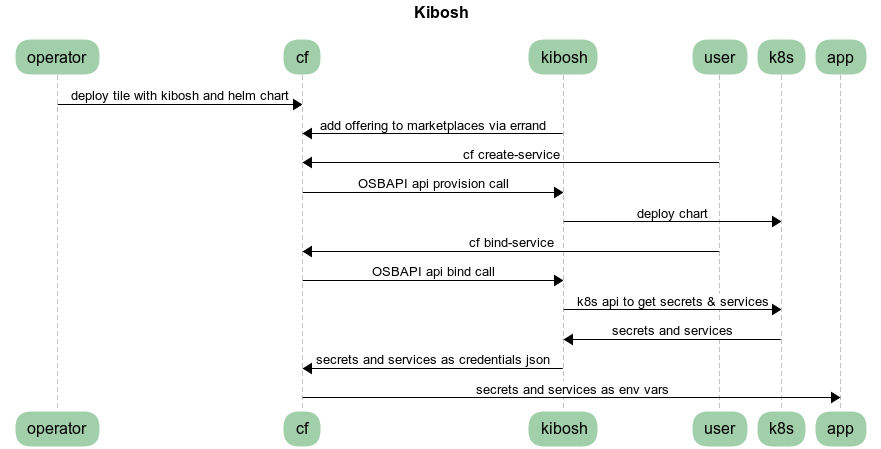An open service broker bridging the gap between Kubernetes deployments and CF marketplace.
When deployed with a Helm chart and added to the marketplace,
cf create-servicecalls to Kibosh will create the collection of Kubernetes resources described by the chart.cf bind-servicecalls to Kibosh will expose back any services and secrets created by the chart
The format of the json string is a nested format.
Also refer to the cf cli for an example of a valid JSON object.
Example: Setting the mysqlUser on cf create-service for the MySQL chart
values.yaml
##
# mysqlUser:
# mysqlPassword:
cf create-service mysql medium mysql-kibosh-service -c '{"mysqlUser":"admin"}'
Example: Setting the resources.requests.memory on cf update-service for the MySQL chart
values.yaml
## ref: http://kubernetes.io/docs/user-guide/compute-resources/
##
resources:
requests:
memory: 256Mi
cpu: 100m
cf update-service mysql-kibosh-service -c '{"resources": {"requests": {"memory": "256Mi"}}}'
For some in depth discussion, see this blog post: Use Kubernetes Helm Packages to Build Pivotal Cloud Foundry tiles
Kibosh requires that helm chart has additional file that describes plan in plans.yaml at root level
- name: "small"
description: "default (small) plan for mysql"
file: "small.yaml"
- name: "medium"
description: "medium sized plan for mysql"
file: "medium.yaml"fileis a filename that exists in theplanssubdirectory of the chart.- File names should consist of only lowercase letters, digits,
., or-. - The standard
values.yamlfile in the helm chart sets the defaults. - Each plan's yaml file is a set of values overriding the defaults present in
values.yaml.
Copy any key/value pairs to override from values.yaml into a new plan file and change their value.
See kibosh-sample's sample-charts for a few examples.
In order to successfully pull private images, we're imposing some requirements
on the values.yaml file structure
- Single-image charts should use this structure:
--- image: "my-image" imageTag: "5.7.14"
- Multi-image charts shoud use this structure:
--- images: thing1: image: "my-first-image" imageTag: "5.7.14" thing2: image: "my-second-image" imageTag: "1.2.3"
This feature is experimental and the syntax will likely change in the future
By default, Kibosh will create all deployments in the same cluster. It's also possible for each plan to
target a different cluster. In plans.yaml, the plan specifies a credentials file:
---
- name: "small"
description: "default (small) plan for mysql"
file: "small.yaml"
credentials: "small-creds.yaml"The contents of this file mirror what would appear in the .kube/config file. For example, small-creds.yaml
would contain:
---
apiVersion: v1
clusters:
- cluster:
certificate-authority-data: bXktY2VydA==
server: https://pks.example.com
name: my-cluster
contexts:
- context:
cluster: my-cluster
user: my-user
name: my-cluster
current-context: my-cluster
kind: Config
preferences: {}
users:
- name: my-user
user:
token: eyJhbGciOiJIUzI1NiIsInR5cCI6IkpXVCJ9.eyJzdWIiOiIxMjM0NTY3ODkwIiwibmFtZSI6IkpvaG4gRG9lIiwiaWF0IjoxNTE2MjM5MDIyfQ.SflKxwRJSMeKKF2QT4fwpMeJf36POk6yJV_adQssw5cDevelopers and libraries often have specific assumptions around how the bind environment variable should be structured. For example, Spring Cloud Connectors will automatically support a service if the right structure is present.
Chart authors can transform what the Kibosh broker returns by writing a
Jsonnet template and putting it in the bind.yaml file
in the root of the Chart. For example, the bind.yaml following will transform the bind
response into a readily consumable structure:
template: |
{
hostname: $.services[0].status.loadBalancer.ingress[0].ip,
name: $.services[0].name,
jdbcUrl: "jdbc:mysql://" + self.hostname + "/my_db?user=" + self.username + "&password=" + self.password + "&useSSL=false",
uri: "mysql://" + self.username + ":" + self.password + "@" + self.hostname + ":" + self.port + "/my_db?reconnect=true",
password: $.secrets[0].data['mysql-root-password'],
port: 3306,
username: "root"
}The template is executed in an environment has top-level services and secrets,
which are json marshalled versions of the services and secrets in the namespace
generated for the service.
To test your bind template, use the template-tester binary from the github release. It takes the namespace in which you have already deployed your helm chart and the file that has the Jsonnet template descrited above.
template-tester mynamespaceid bind.yamlNote: In order to follow the steps for Credhub integration, you should have some familiarity with UAA and UAAC
Kibosh can be configured to store binding credentials in CredHub. To do so, include the following environment variables in the Kibosh configuration.
CH_CRED_HUB_URL: https://[credhub-url]
CH_UAA_URL: https://[credhub-uaa-url]
CH_UAA_CLIENT_NAME: [my-uaa-client]
CH_UAA_CLIENT_SECRET: [my-uaa-secret]
CH_SKIP_SSL_VALIDATION: true
Firstly, the Kibosh UAA client needs to created and given the correct scope in order to store credentials in Credhub. Use the uaac cli to do so. You must know the UAA URL and UAA admin client secret.
If using the CF runtime credhub, the UAA URL is uaa.[system-domain].
uaac target https://[credhub-uaa-url] --skip-ssl-validation
uaac token client get admin
uaac client add my-uaa-client \
--access_token_validity 1209600 \
--authorized_grant_types client_credentials,refresh_token \
-s my-uaa-secret \
--scope openid,oauth.approvals,credhub.read,credhub.write \
--authorities oauth.login,credhub.read,credhub.writeSecondly, you must get the token for the Credhub Admin client. You must know the Credhub admin client secret to do so. If using PCF, you can find the Credhub admin client secret from "Credhub Admin Client Client Credentials" in Ops Manager.
uaac token client get credhub_admin_client
# get the token by viewing the context
uaac contextFinally, give our newly created client access to modify creds in CredHub. This can be done via curl.
curl -k "https://[credhub-url]/api/v2/permissions" \
-X POST \
-d '{
"path": "/c/kibosh/*",
"actor": "uaa-client:my-uaa-client",
"operations": ["read", "write", "delete", "read_acl", "write_acl"]
}' \
-H "authorization: bearer [CREDHUB-ADMIN-CLIENT-TOKEN]" \
-H 'content-type: application/json'
The CF runtime CredHub does not expose an external url, so testing with CredHub can be done by
- Running a proxy app on the platform to expose runtime Credhub url externally
- Pushing Kibosh broker as an app OR Running Kibosh in a BOSH release
To run a proxy, cf push the app located in docs/credhub_proxy. The proxy
will then make credhub available at https://credhub-proxy.<cf apps domain>.
Then add the following set of environment variables to configure the Kibosh process:
CH_CRED_HUB_URL: https://credhub-proxy.[apps-domain]
CH_UAA_URL: https://uaa.[system-domain]
CH_UAA_CLIENT_NAME: my-uaa-client
CH_UAA_CLIENT_SECRET: my-uaa-secret
CH_SKIP_SSL_VALIDATION: trueTo push the Kibosh broker as an app, use the sample manifest and run cf push from the Kibosh project root.
Then run cf create-service-broker SERVICE_BROKER USERNAME PASSWORD URL to register the broker with CF.
Once you provision and bind a service from Kibosh, running cf env agains the application should return a placeholder value to Credhub instead of the credentials in plain text.
- When defining a
Service, to expose this back to any applications that are bound,type: LoadBalanceris a current requirement.NodePortis also an option and Kibosh will add externalIPs and nodePort to bind json, butNodePortdoes carry significant risks and probably should not be used in production: is not robust to cluster scaling events, upgrades or other IP changes. - Resizing disks has limitiations. To support upgrade:
- You can't resize a persistent volume claim (currently behind an alpha feature gate)
- Selectors are immutable
- This means that chart name cannot change (the name is generally used in selectors)
When the environment settings for a private registry are present (REG_SERVER, REG_USER, REG_PASS),
then Kibosh will transform images to pull them from the private registry. It assumes
the image is already present (see the Kibosh deployment). It will patch
the default service account in the instance namespaces to add in the registry credentials.
Be sure that REG_SERVER contains any required path information. For example, in gcp gcr.io/my-project-name
We welcome comments, questions, and contributions from community members. Please consider the following ways to contribute:
- File Github issues for questions, bugs and new features and comment and vote on the ones that you are interested in.
- If you want to contribute code, please make your code changes on a fork of this repository and submit a pull request to the master branch of Kibosh. We strongly suggest that you first file an issue to let us know of your intent, or comment on the issue you are planning to address.
To manually deploy the BOSH release, get the latest BOSH release (kibosh-release-X.X.XX.tgz)
from the Github releases and upload
to your director.
Build a manifest by starting from the example bosh-lite manifest
lite-manifest.yml
and customize the cloud specific settings (az, vm_type, etc). This manifest
uses a set of input variables.
See
values-sample.yml
for example values.
Clone the repo (recommended to clone outside of $GOPATH because using go modules).
Run make bootstrap from a clean checkout to setup initial dependencies. This will set up the dependencies
in the go.sum file as well as get external binary tools (counterfeiter, ginkgo, etc).
Copy local_dev.sh.template to local_dev.sh (which is in .gitignore) and
configure the values (cluster.certificate-authority-data, cluster.server, and user.token)
for a working cluster. Then run:
./local_dev.shMake sure minikube is running:
minikube start --vm-driver=hyperkitUse local_dev_minikube to set up all the secrets and start kibosh:
local_dev_minikube.shIn production, tiller should be secured. It's probably good practice to use secure tiller in your local environment as well (at least some of the time) to catch issues.
To generate a set of credentials, run tiller_ssl.sh from inside
docs/tiller-ssl/. This will create a CA cert, a cert/key pair for Tiller, and a client cert/key pair.
If debugging using the helm cli, include the tls flags. For example:
helm ls --all --tls-verify --tls-ca-cert docs/tiller-ssl/ca.cert.pem --tls-cert docs/tiller-ssl/tiller.cert.pem --tls-key docs/tiller-ssl/tiller.key.pemSee Helm's tiller_ssl.md for more details.
The Kibosh code loads charts from the HELM_CHART_DIR, which defaults to charts.
This directory can either be a single chart (with all the changes described in the
configuration, eg plans.yaml and ./plans), or, directory where each
subdirectory is a chart. The multiple charts feature isn't yet supported by tile-generator.
charts
├── mariadb
│ ├── Chart.yaml
├── plans
│ ├── medium.yaml
│ └── small.yaml
├── plans.yaml
├── templates
...
└── mysql
├── Chart.yaml
├── plans
│ └── default.yaml
...
We have modified some example charts from stable helm repository.
make testTo generate the test-doubles, after any interface change run:
make generateFor manual testing, there is a Python test harness.
The integration testing suite is located in test/suite.py. The suite will
sequentially run through the OSBAPI lifecycle and exit at the first failure (so as to leave things
in a state for debugging). test/test_broker_base.py processes environment
variables $BROKER_HOST, $BROKER_USERNAME, $BROKER_PASSWORD to determine the broker to connect to.
Prerequisites:
- Install required python packages listed in test/requirements.txt
- i.e.
pip3 install -r test/requirements.txt
- i.e.
- Unpackaged (untarred) MySQL helm chart is in
/chartsdirectory at root of kibosh project kubectlis available on the path and configured to talk to the same cluster that kibosh will provision to.
Run with command: python3 test/suite.py
The pipeline is backed by a cluster in the shared GKE account. The default admin user in GKE has a password while Kibosh is configured to use a token. To create a user in the cluster and fetch the token, do something like:
apiVersion: v1
kind: ServiceAccount
metadata:
name: kibosh-concourse-ci
namespace: kube-system
---
apiVersion: rbac.authorization.k8s.io/v1beta1
kind: ClusterRoleBinding
metadata:
name: kibosh-concourse-ci
roleRef:
apiGroup: rbac.authorization.k8s.io
kind: ClusterRole
name: cluster-admin
subjects:
- kind: ServiceAccount
name: kibosh-concourse-ci
namespace: kube-systemkubectl create -f [above contents in file].yml
kubectl get secrets --namespace=kube-system | grep "kibosh-concourse-ci"
kubectl get secret --namespace=kube-system kibosh-concourse-ci-token-pfnqs -o yamlSequence diagram source
via https://www.websequencediagrams.com/ title Kibosh
operator->cf: deploy tile with kibosh and helm chart
kibosh->cf: add offering to marketplaces via errand
user->cf: cf create-service
cf->kibosh: OSBAPI api provision call
kibosh-> k8s: deploy chart
user->cf: cf bind-service
cf->kibosh: OSBAPI api bind call
kibosh-> k8s: k8s api to get secrets & services
k8s->kibosh: secrets and services
kibosh->cf: secrets and services as credentials json
cf->app: secrets and services as env vars

